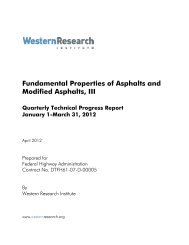Fundamental Properties of Asphalts and Modified Asphalts, III
Fundamental Properties of Asphalts and Modified Asphalts, III
Fundamental Properties of Asphalts and Modified Asphalts, III
Create successful ePaper yourself
Turn your PDF publications into a flip-book with our unique Google optimized e-Paper software.
SUBTASK 2-5. MODIFIED ASPHALTS (continuing on Year-1 funds)<br />
Statement <strong>of</strong> Problem<br />
Asphalt modifiers are <strong>of</strong>ten added to meet binder purchase specifications. Common modifiers<br />
include polymers to improve rutting resistance, lime <strong>and</strong> antistrip additives to mitigate moisture<br />
damage, polyphosphoric acid for rutting resistance, <strong>and</strong> reclaimed asphalt pavement (RAP) for<br />
reducing costs. New modifiers are also being introduced to enable warm-mix asphalt (WMA)<br />
technologies where mix <strong>and</strong> compaction temperatures can be substantially reduced. One <strong>of</strong> these<br />
modifiers is water (typically used to foam the asphalt), which improves the workability <strong>of</strong><br />
binders at mixing <strong>and</strong> laydown temperatures <strong>and</strong> appears to have little effect afterwards,<br />
although there is some evidence that entrapped moisture may increase stripping [Hurley <strong>and</strong><br />
Prowell 2005]. In addition, the long-term effectiveness <strong>of</strong> some modifiers under highway<br />
conditions is not known. Often, the mechanism <strong>of</strong> action <strong>of</strong> a modifier is understood only in an<br />
empirical sense <strong>and</strong> the effective treatment levels <strong>and</strong> economical treatment levels may differ. It<br />
is also important to point out that modifier interactions may reduce effectiveness <strong>and</strong> waste<br />
resources.<br />
Approaches<br />
The sensitivity <strong>of</strong> PPA-modified asphalts to environmental factors is being determined using<br />
laboratory PAV aging tests on modified <strong>and</strong> unmodified asphalts in the presence <strong>and</strong> absence <strong>of</strong><br />
moisture in the oven. Analytical tests applied include spectroscopic (FTIR) <strong>and</strong> rheologic (DSR)<br />
<strong>of</strong> the aged materials. Master curve <strong>and</strong> shift factors are used to quantify changes.<br />
Nuclear magnetic resonance techniques are being applied to study the reactions between<br />
phosphorous-containing additives including antistrips <strong>and</strong> PPA in asphalts.<br />
Goals<br />
The goal <strong>of</strong> this research is to develop a detailed description <strong>of</strong> the actions <strong>of</strong> modifiers in<br />
asphalts while varying environmental conditions. Where feasible, efforts are directed toward<br />
developing relationships for predicting long-term behavior from initial laboratory tests.<br />
Support <strong>of</strong> FHWA Strategic Goals<br />
The work conducted in this subtask supports the FHWA strategic goal that addresses<br />
environmental stewardship <strong>and</strong> safety. State agencies need a better underst<strong>and</strong>ing <strong>of</strong> how <strong>and</strong><br />
when to use additives, such as recycled asphalt pavement (RAP), polymers <strong>and</strong>/or<br />
polyphosphoric acid (PPA), to improve the performance <strong>of</strong> asphalt pavements. Obviously, better<br />
performing <strong>and</strong> longer lasting asphalt pavements, which incorporate the use <strong>of</strong> RAP, lead to the<br />
utilization <strong>of</strong> less asphalt, thus decreasing the dem<strong>and</strong> for reconstruction <strong>of</strong> pavements <strong>and</strong><br />
incidentally safer roads.<br />
57





